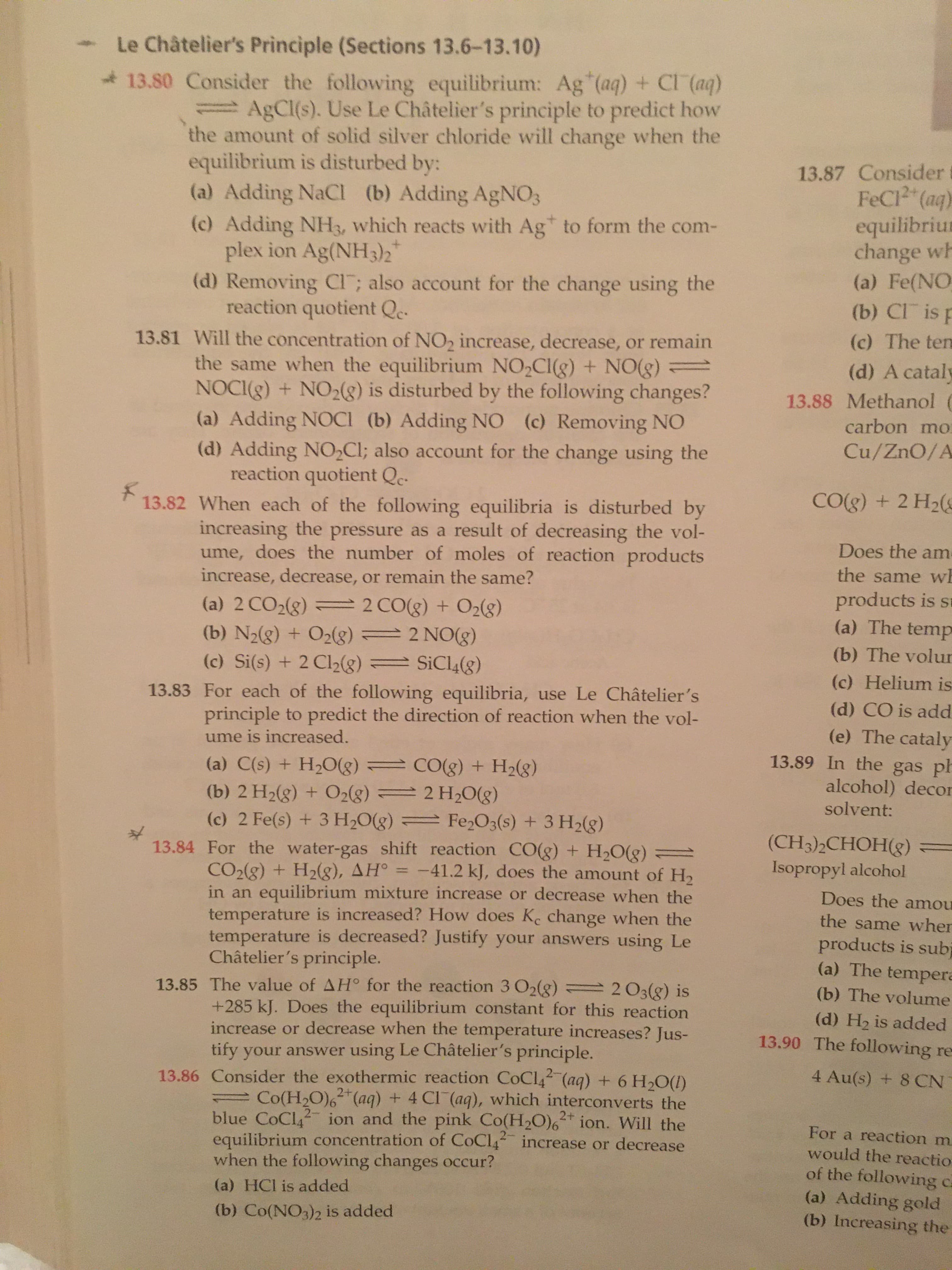Le Châtelier's Principle (Sections 13.6-13.10) 13.80 Consider the following equilibrium: Ag (aq) + Cl (aq) AgCl(s). Use Le Châtelier's principle to predict how the amount of solid silver chloride will change when the equilibrium is disturbed by: (a) Adding NaCI (b) Adding AGNO3 (c) Adding NH3, which reacts with Ag to form the com- plex ion Ag(NH)2 (d) Removing CI"; also account for the change using the reaction quotient Qe- 1.
Le Châtelier's Principle (Sections 13.6-13.10) 13.80 Consider the following equilibrium: Ag (aq) + Cl (aq) AgCl(s). Use Le Châtelier's principle to predict how the amount of solid silver chloride will change when the equilibrium is disturbed by: (a) Adding NaCI (b) Adding AGNO3 (c) Adding NH3, which reacts with Ag to form the com- plex ion Ag(NH)2 (d) Removing CI"; also account for the change using the reaction quotient Qe- 1.
Chemistry for Today: General, Organic, and Biochemistry
9th Edition
ISBN:9781305960060
Author:Spencer L. Seager, Michael R. Slabaugh, Maren S. Hansen
Publisher:Spencer L. Seager, Michael R. Slabaugh, Maren S. Hansen
Chapter8: Reaction Rates And Equilibrium
Section: Chapter Questions
Problem 8.49E: Consider the following equilibrium constants. Describe how you would expect the equilibrium...
Related questions
Question
Can you please answer question 13.80 and all of the sub problems and show all of the step to the solution

Transcribed Image Text:Le Châtelier's Principle (Sections 13.6-13.10)
13.80 Consider the following equilibrium: Ag (aq) + Cl (aq)
AgCl(s). Use Le Châtelier's principle to predict how
the amount of solid silver chloride will change when the
equilibrium is disturbed by:
(a) Adding NaCI (b) Adding AGNO3
(c) Adding NH3, which reacts with Ag to form the com-
plex ion Ag(NH)2
(d) Removing CI"; also account for the change using the
reaction quotient Qe-
1.
Expert Solution
This question has been solved!
Explore an expertly crafted, step-by-step solution for a thorough understanding of key concepts.
This is a popular solution!
Trending now
This is a popular solution!
Step by step
Solved in 2 steps

Knowledge Booster
Learn more about
Need a deep-dive on the concept behind this application? Look no further. Learn more about this topic, chemistry and related others by exploring similar questions and additional content below.Recommended textbooks for you

Chemistry for Today: General, Organic, and Bioche…
Chemistry
ISBN:
9781305960060
Author:
Spencer L. Seager, Michael R. Slabaugh, Maren S. Hansen
Publisher:
Cengage Learning


Chemistry by OpenStax (2015-05-04)
Chemistry
ISBN:
9781938168390
Author:
Klaus Theopold, Richard H Langley, Paul Flowers, William R. Robinson, Mark Blaser
Publisher:
OpenStax

Chemistry for Today: General, Organic, and Bioche…
Chemistry
ISBN:
9781305960060
Author:
Spencer L. Seager, Michael R. Slabaugh, Maren S. Hansen
Publisher:
Cengage Learning


Chemistry by OpenStax (2015-05-04)
Chemistry
ISBN:
9781938168390
Author:
Klaus Theopold, Richard H Langley, Paul Flowers, William R. Robinson, Mark Blaser
Publisher:
OpenStax

Chemistry for Engineering Students
Chemistry
ISBN:
9781337398909
Author:
Lawrence S. Brown, Tom Holme
Publisher:
Cengage Learning

Introductory Chemistry: A Foundation
Chemistry
ISBN:
9781337399425
Author:
Steven S. Zumdahl, Donald J. DeCoste
Publisher:
Cengage Learning

Chemistry: Matter and Change
Chemistry
ISBN:
9780078746376
Author:
Dinah Zike, Laurel Dingrando, Nicholas Hainen, Cheryl Wistrom
Publisher:
Glencoe/McGraw-Hill School Pub Co